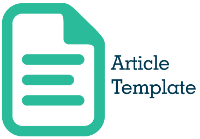THE TRUST IN THE RITUAL’S “CAMBUK BERDARAH” WHIP IN SUMBERINGIN VILLAGE BLITAR REGENCY
DOI:
https://doi.org/10.35457/jares.v6i1.1412Keywords:
Keywords: Trust, Society, Bloody Whip RitualAbstract
Regional culture is the wealth of a country in strengthening national culture. The extinction of a regional culture must be watched out for, for that it is our duty together to protect and preserve regional culture. Researchers are interested in researching the tradition of the bloody whip in Sumberingin Village, Blitar Regency. The objectives of this study are: (1) to analyze the role of social capital in the preservation of the tradition of the bloody whip in Sumberingin Village, Blitar Regency, (2) to analyze the supporting and inhibiting factors in the preservation of the bloody whip tradition in Sumberingin Village, Blitar Regency. The research method is qualitative. The results showed: The conclusions are as follows: (1) The role of social capital in the Preservation of the Bloody Whip Ritual in Sumberingin Village, Blitar Regency is: (a) Bonding or social glue, which contributes separately to the occurrence of social integration, (b) Social Bridging, namely bridges. social is to form community social solidarity within the frame of willingness or volunteering or sincerity in accordance with the ability to participate actively in accordance with their respective abilities and fields, (2) Supporting factors in Preserving the Tradition of Bloody Whip to Reduce Rain in Sumberingin Village, Blitar Regency are: ( 1) the community has solidarity, togetherness in agawe or creating a celebration, (2) strong social ties between residents of the Sumberingin Village community and members of the community outside the village, fellow cultural preservationists (3) Participation and community care and cooperation between residents in realizing art performances and tradition.
Downloads
References
Jurnal ANUVA, Volume 2 (1): 19-27. ISSN: 2598-3040. http://ejournal.undip.ac.id/index.php/anuva diakses pada tanggal 15 Juli 2020
Kurnia Firmansyah Eka, 2017. Sistem Religu dan kepercayaan Masyarakat Kampung Adat Kuta Kecamatan Tambaksari Kabupaten Ciamis. Jurnal Pengabdian Kepada Masyarakat ISSN 1410 – 5675 Vol. 1.No. 4 Agustus 2017: 236 – 243. Universitas Padjajaran.
Moleong, Lexy, 2011. Metodologi Penelitian Kualitatif. Bandung. PT Remaja Rosdakarya.
Nina Putri hayam Dey. 2019. Modal Sosial Dewan Adat Dayak (Dad) Kabupaten, Dalam Melestarikan Kearifan Lokal Di Kabupaten Lamandau, Provinsi Kalimantan Tengah. Civic-Culture: Jurnal Ilmu Pendidikan PKn dan Sosial Budaya. http://jurnal.stkippgri-bkl.ac.id/index.php/CC diakses pada tanggal 15 Juli 2020.
Sugiyono, 2011. Metode Penelitian Kuantitatif Kualitatif dan R&D . Bandung. Alfabeta.
Suharto, Edi, 2010, Membangun Masyarakat Memberdayan Rakyat, Kajian Strategis Pembangunan Kesejahteraan Sosial dan Pekerjaan Sosial. Bandung. PT Refika Aditama.
Sumodingrat, Gunawan, 2000. Visi dan Misi Pembangunan Pertanian Berbasis Pemberdayaan. Yogjakarat: IDEA.
Sumodiningrat, Gunawan, 2011. Membangun Perekonomian Rakyat. Yogjakarta. Pustaka Pelajar.
Soekamto, Soejono, 2010. Sosiologi Suatu Pengantar.Jakarta, PR Rajagrafindo Persada.
Yulianti, Yayuk. 2011. Perubahan Ekologis dan Strategis Adaptasi Masyarakat di Wilayah Pegunungan Tengger (Suatu Kajian Gender dan Lingkungan). Malang UB Press.
https://edukasi.kompas.com/read/2020/02/21/17464191/data-kemendikbud-2011-2019-11-bahasa-daerah-di-indonesia-punah?page=all diakses pada tanggal 14 Juli 2020
https://metateoricomm.wordpress.com/teori-budaya/ diakses pada tanggal 15 Juli 2020
https://www.kompasiana.com/shinta20295/5b8ab291677ffb1c1e38bfa2/ini-yang-mesti-dilakukan-generasi-milenial-terhadap-warisan-budaya-bangsa-indonesia/ diakses pada tanggal 10 Nopembet 2020
Downloads
Published
Issue
Section
License
Authors who publish with this journal agree to the following terms:
- Copyright on any article is retained by the author(s).
- Author grant the journal, right of first publication with the work simultaneously licensed under a Creative Commons Attribution License that allows others to share the work with an acknowledgement of the work’s authorship and initial publication in this journal.
- Authors are able to enter into separate, additional contractual arrangements for the non-exclusive distribution of the journal’s published version of the work (e.g., post it to an institutional repository or publish it in a book), with an acknowledgement of its initial publication in this journal.
- Authors are permitted and encouraged to post their work online (e.g., in institutional repositories or on their website) prior to and during the submission process, as it can lead to productive exchanges, as well as earlier and greater citation of published work.
- The article and any associated published material is distributed under the Creative Commons Attribution-ShareAlike 4.0 International License














